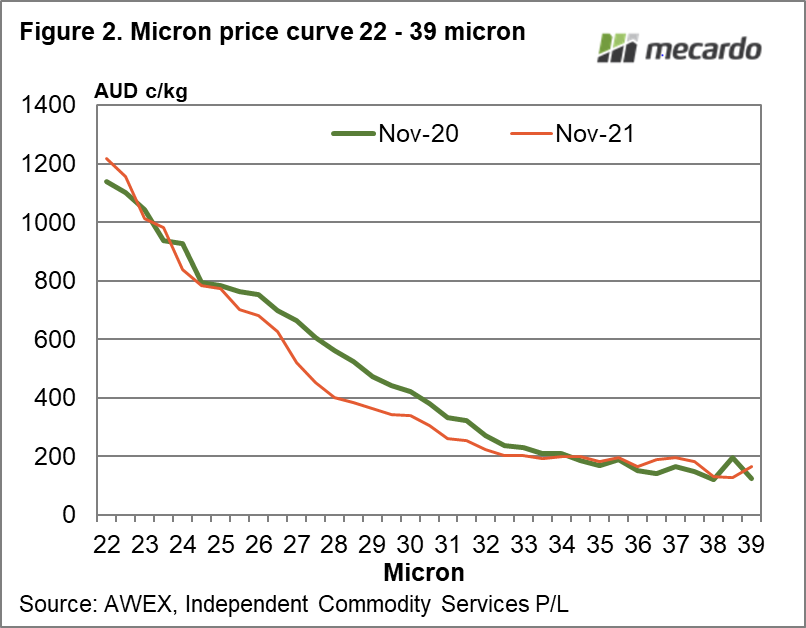Amongst the week to week torrent of information which rushes from a range of sources (some new and some old) it is easy to lose sight of some basic data, such as where are prices sitting at present. This article updates the micron price curve for November.
The emergence of large premiums for RWS accredited wool (see article from last month) this season has been a big story in the greasy wool market. In the background the world economies have been emerging (hopefully) from the shock of COVID 19, China has had energy issues which have disrupted manufacturing plus the all usual uncertainties about commodity markets and long supply chain. It all adds up to plenty of noise surrounding the greasy wool market.
Figure 1 shows the average combing fleece price curve for November from 13.5 to 24 micron, as well as the price curve for November 2020. In November the curve ran from 7400 cents to 837 cents. Around 22-24 micron the wool switches over from merino dominant to mainly crossbred. In terms of price movements the past year has been a finer merino story. The base 19 micron price is some 18% above year ago price levels, with the increase growing through to 82-83% for 13.5-14 micron. 21 micron is around 9% above November 2020 levels.
In Figure 2 the analysis is repeated for the fibre diameter range 22 through to 39 micron. The core Australian crossbred micron categories (26 to 32 micron roughly) are clearly lower than a year ago, down by 20% on average. Last week’s article (view article here), showed how the 28 MPG has fallen to three decades lows in comparison to acrylic staple fibre prices.
The article about merino micron premiums and discounts also from last month (view article here), showed that the merino micron price curve was at extreme levels. It remains at extremely high levels, with trades for fine merino wool both at auction and privately, reflecting these elevated micron premiums.
What does it mean?
Fine merino prices continue to trade at high levels, perhaps not as high as 2017-2018, but high nonetheless. For them to move to further higher price levels, either supply must shrink and or demand pick up markedly. The swing in merino micron points to supply growing rather than shrinking for fine wool, while the economic backdrop to the market does not point to a boom in retail demand in 2022.
Have any questions or comments?
Key Points
- Amongst all the noise surrounding the greasy wool market fine wool prices remain at high levels, both in outright terms and compared to medium/broad merino prices.
- 26-33 micron prices have slumped compared to year ago price levels, by an average of 20%.
- Medium merino (19 micron) is 18% above November 2020 levels, with the increase in price growing as fibre diameter becomes less.
Click on figure to expand
Click on figure to expand
Data sources: AWEX, ICS



